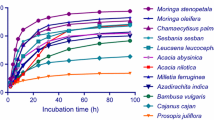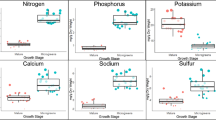Abstract
Moringa stenopetala and Moringa oleifera are multipurpose trees widely grown in the tropics and sub-tropics. The aim of this study was to investigate the variability in nutritive values of leaves and green pods of M. stenopetala and M. oleifera as influenced by species, elevation and season. Leaves and green pods were collected from each three trees of M. stenopetala and M. oleifera grown at two different elevations in rainy and dry seasons. In leaves, crude protein (CP) content (g/kg DM) averaged 263 in M. stenopetala and 290 in M. oleifera. In green pods, the highest and lowest CP concentrations (g/kg DM) were 184 and 153 for M. stenopetala at low and mid elevations, respectively. Leaves contained higher fat concentration than green pods. Compared to leaves, green pods had a high level of structural carbohydrates. At low elevation, the concentrations of calcium (Ca), phosphorus (P), potassium (K), magnesium (Mg) and trace minerals zinc (Zn) and copper (Cu) were highest whereas that of sodium (Na) and trace mineral manganese (Mn) were lowest in M. stenopetala leaves compared to those of M. oleifera. Green pods of M. oleifera contained higher concentrations of P and trace minerals iron (Fe), Mn, Zn and Cu. Leaves contained greater concentrations of essential amino acids than green pods and levels generally were comparable to concentrations found in soybean. In leaves, except for lysine and arginine, essential amino acid concentrations were similar across Moringa species. Except for aspartic acid, phenylalanine and serine, amino acid concentrations in M. stenopetala leaves at mid elevation were higher than those at low elevation. However, the amino acid concentrations in M. oleifera leaves were similar between low and mid elevations. In conclusion, leaves and green pods could serve as valuable sources of protein supplement for ruminants in the tropics during the dry season. Moreover, due to their excellent amino acid profiles, leaves could be used as potential sources of feed for non-ruminants and humans.
Similar content being viewed by others
References
Anele UY, Arigbede OM, Südekum KH, Oni AO, Jolaosho AO, Olanite JA, Adeosun AI, Dele PA, Ike KA, Akinola OB (2009) Seasonal chemical composition, in vitro fermentation and in sacco dry matter degradation of four indigenous multipurpose tree species in Nigeria. Anim Feed Sci Technol 154:47–57
Aregheore EM (2002) Intake and digestibility of Moringa oleifera–batiki grass mixtures by growing goats. Small Rumin Res 46:23–28
Aregheore EM, Yahaya MS (2001) Nutritive value of some browses as supplements for goats. Malays J Anim Sci 7:29–36
Arigbede OM, Anele UY, Olanite JA, Adekunle IO, Jolaosho OA, Onifade OS (2006) Seasonal in vitro gas production parameters of three multipurpose tree species in Abeokuta, Nigeria. Livestock Research for Rural Development, vol 18, Article 142. Retrieved 29 Feb 2011 from http://www.lrrd.org/lrrd18/10/arig18142.htm
Babayemi OJ (2007) In vitro fermentation characteristics and acceptability by West African dwarf goats of some dry season forages. Afr J Biotechnol 6(10):1260–1265
Bamishaiye EI, Olayemi FF, Awagu EF, Bamshaiye OM (2011) Proximate and phytochemical composition of Moringa oleifera leaves at three stages of maturation. Adv J Food Sci Technol 3(4):233–237
Booth FEM, Wickens GE (1988) Non-timber uses of selected arid zone trees and shrubs in Africa. FAO conservation guide, Rome, pp 92–101
Bueno ICS, Filho SLS, Godoy PB, Abdalla AL (2010) Comparison of in situ and in vitro dry matter rumen degradability of three distinct quality hays in sheep. Trop Subtrop Agroecosys 12:321–332
Devaraj VC, Asad M, Prasad S (2007) Effect of leaves and fruits of Moringa oleifera on gastric and duodenal ulcers. Pharm Biol 45(4):332–338
Evitayani L, Warly A, Fariani T, Ichinohe S, Abdulrazak A, Fujihara T (2004) Comparative rumen degradability of some legumes forages between wet and dry seasons in west Sumatra, Indonesia. Asian-Aust J Anim Sci 17:1107–1111
Foidl N, Makkar HPS, Becker K (2001) The potential of Moringa oleifera for agricultural and industrial uses. In: Fuglie LJ (ed) The miracle tree: the multiple attributes of Moringa. CTA Publication, Wageningen, pp 45–76
Gengelbach GP, Ward JD, Spears JW (1994) Effect of dietary copper, iron, and molybdenum on growth and copper status of beef cows and calves. J Anim Sci 72:2722–2727
Gizachew L, Hirpha A, Jalata F, Smit GN (2002) Mineral element status of soils, native pastures and cattle blood serum in the mid-altitude of western Ethiopia. Afr J Range Forage Sci 19:147–155
Grubben GJH, Denton OA (2004) Plant resources of tropical Africa 2. Vegetables. PROTA Foundation, Wageningen/Backhuys Publishers, Leiden/CTA, Wageningen
Gupta K, Barat GK, Wagle DS, Chawla HKI (1989) Nutrient contents and anti nutritional factors in conventional and non-conventional leafy vegetables. Food Chem 31:105–116
Jahn SA (1991) The Traditional Domestication of a multipurpose tree Moringa stenopetala (Bak. f.) Cuf. in the Ethiopian Rift Valley. Ambio 20:244–247
Jongrungruangchok S, Bunrathep S, Songsak T (2010) Nutrients and minerals content of eleven different samples of Moringa oleifera cultivated in Thailand. J Health Res 24(3):123–127
Larbi A, Smith JW, Kurdi IO, Adekunle IO, Raji AM, Ladipo DO (1998) Chemical composition, rumen degradation, and gas production characteristics of some multipurpose fodder trees and shrubs during wet and dry seasons in the humid tropics. Anim Feed Sci Technol 72:81–96
Makkar HPS, Becker K (1996) Nutritional value and anti-nutritional components of whole and ethanol extracted Moringa oleifera leaves. Anim Feed Sci Technol 63:211–228
Makkar HPS, Becker K (1997) Nutrients and anti-quality factors in different morphological parts of the Moringa oleifera tree. J Agric Sci 128:311–322
Mandal L (1997) Nutritive value of tree leaves of some tropical species for goats. Small Rumin Res 24:95–105
Mataka LM, Sajidu SMI, Masamba WRL, Mwatseteza JF (2010) Cadmium sorption by Moringa stenopetala and Moringa oleifera seed powders: batch, time, temperature, pH and adsorption isotherm studies. Int J Water Resour Environ Eng 2(3):50–59
Melesse A, Bulang M, Kluth H (2009) Evaluating the nutritive values and in vitro degradability characteristics of leaves, seeds and seedpods from M. stenopetala. J Sci Food Agric 89:281–287
Melesse A, Tiruneh W, Negesse T (2011) Effects of feeding Moringa stenopetala leaf meal on nutrient intake and growth performance of Rhode Island Red chicks under tropical climate. Trop Subtrop Agroecosys 14:485–492
NRC (National Research Council) (2001) Nutrient requirements of dairy cattle, 7th revised edn, National Academy Press, Washington, DC
Negesse T, Makkar HPS, Becker K (2009) Nutritive value of some non-conventional feed resources of Ethiopia determined by chemical analyses and an in vitro gas method. Anim Feed Sci Technol 154:204–217
NMA (National Metrological Agency) (2012) Awassa Branch Directorate. Southern Nations, Nationalities and Peoples of Regional State, Ethiopia
Odee D (1998) Forest biotechnology research in dry lands of Kenya: the development of Moringa species. Dryland Biodivers 2:7–8
Oduro I, Ellis WO, Owusu D (2008) Nutritional potential of two leafy vegetables: Moringa oleifera and Impomea batatas leaves. Sci Res Essay 3(2):57–60
Rodehutscord M, Dieckmann A (2005) Comparative studies with three-week-old chickens, turkeys, ducks, and quails on the response in phosphorus utilization to a supplementation of monobasic calcium phosphate. Poult Sci 84:1252–1260
Sanchez NR, Sporndly E, Ledin I (2006a) Effect of feeding different levels of foliage of Moringa oleifera to creole dairy cows on intake, digestibility, milk production and composition. Livest Sci 101:24–31
Sanchez NR, Ledin S, Ledin I (2006b) Biomass production and chemical composition of Moringa oleifera under different management regimes in Nicaragua. Agrofor Syst 66(3):231–242
Sarkar G, Peace RW (1994) The protein quality of some enteral products is inferior to that of casein as assessed by rat growth methods and digestibility-corrected amino acid scores. J Nutr 124:2223–2232
Sarwatt SV, Kapange SS, Kakengi AMV (2002) Substituting sunflower seed-cake with Moringa oleifera leaves as supplemental goat feed in Tanzania. Agrofor Syst 56:241–247
Singh B, Bhatt BP, Prasad P (2010) Altitudinal variation in nutritive value of adult-juvenile foliage of Celtis australis L.: a promising fodder tree species of Central Himalaya, India. J Am Sci 6(2):108–112
Soliva CR, Kreuzer M, Foidl N, Foidl G, Machmüller A, Hess HD (2005) Feeding value of whole and extracted Moringa olifera leaves for ruminants and their effects on ruminal fermentation in vitro. Anim Feed Sci Technol 118:47–62
SAS (1996) Statistical Analysis System SAS/STAT Guide version 6.12. SAS, Institute Inc., Raleigh, North Carolina, USA
Todaria NP, Purohit AN (1979) Functional dynamics of plants at different altitudes. I. Growth pattern of Artemisia vulgaris. Indian J Plant Physiol 22:231–241
Topps JH (1992) Potential, composition and use of legume shrubs and tress as fodders for livestock in the tropics. J Agric Sci 118:1–8
van Soest PJ (1994) Nutritional ecology of the ruminant, 2nd edn. Comstock publishing Associates/Cornell University, Ithaca
VDLUFA (Verband Deutscher Landwirtschaftlicher Untersuchungs- und Forschungsanstalten) (2006) Handbuch der Landwirtschaftlichen Versuchs- und Untersuchungsmethodik (VDLUFA-Methodenbuch), Bd. III Die chemische Untersuchung von Futtermitteln. VDLUFA-Verlag, Darmstadt
Winrock (1992) Assessment of animal agriculture in sub-Saharan Africa. Winrock International Institute for Agricultural Development, Morrilton 192 p
Yahaya MS, Kibon A, Aregheore EM, Abdulrazak SA, Takahashi J, Matsuoka S (2001) The evaluation of nutritive value of three tropical browse species for sheep using in vitro and in vivo digestibility. Asian-Aust J Anim Sci 14:496–500
Yang, RY, Chang LC, Hsu JC, Weng BBC., Palada MC., Chadha ML and Levasseur V (2006) Nutritional and functional properties of Moringa leaves: from germplasm, to plant, to food, to health. In: Moringa and other highly nutritious plant resources: strategies, standards and markets for a better impact on nutrition in Africa, Accra, 16–18 Nov 2006
Zarkadas CG, Yu Z, Burrows VD (1995) Protein quality of three new Canadian-developed naked oat cultivars using amino acid compositional data. J Agric Food Chem 43:415–421
Acknowledgments
The first author gratefully acknowledges the visiting scholarship granted by the Food Security Center of University of Hohenheim, which is part of the DAAD (German Academic Exchange Service) Program “exceed” and is supported by DAAD and the German Federal Ministry for Economic Cooperation and Development (BMZ). The same author also thanks Southern Agricultural Research Institute (SARI) and Arbaminch Bureau of Agriculture for their cooperation to use the feed materials.
Author information
Authors and Affiliations
Corresponding author
Rights and permissions
About this article
Cite this article
Melesse, A., Steingass, H., Boguhn, J. et al. Effects of elevation and season on nutrient composition of leaves and green pods of Moringa stenopetala and Moringa oleifera . Agroforest Syst 86, 505–518 (2012). https://doi.org/10.1007/s10457-012-9514-8
Received:
Accepted:
Published:
Issue Date:
DOI: https://doi.org/10.1007/s10457-012-9514-8




